Acer Aspire U27 Review: Desktop Looks, Laptop Power
The Acer Aspire U27 is a good midrange all-in-one, and it sounds good thanks to strong speakers and silent liquid cooling, but the PC's admittedly clever design touches are overshadowed by limited laptop-class hardware.
Why you can trust Tom's Guide
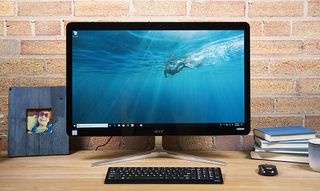
Midrange all-in-one PCs walk a tightrope between delivering premium touches – polished designs and desktop-class power – and cutting costs just enough to avoid running the price into the thousands of dollars. The Acer Aspire U27 is the latest system to walk that tightrope, but the risk is always the same: You can deliver the best at a price that's too dear, or you may deliver an affordable system that falls a little short. While the Aspire U27 manages to walk that line pretty well, it definitely leans toward the latter, making for a pretty good PC that nonetheless leaves us just a little disappointed.
Design
The U27 has a premium design, with a relatively thin chassis, measuring 19.2 x 25.2 x 0.5 inches, not including the stand. The half-inch-thick housing contains both the display and the PC components, and manages to do so while being slimmer than competitors like the Dell Inspiron 27 7000 (2.1 inches).

The chassis is made of both metal and plastic, but the two materials have an identical metallic finish, so you won't notice the different materials used in the construction.
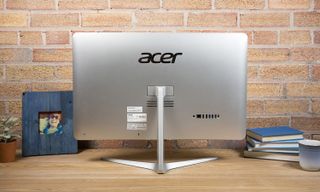
The whole system is held aloft on an aluminum stand, which has a Y-shaped foot and an adjustable angle of tilt. The stand is the one piece of the system that needs to be assembled after unboxing, but the base attaches to the stand with a simple thumbscrew, so you won’t even need a screwdriver.

The U27 keeps things extra quiet by eliminating the cooling fans that most systems use. Instead, the all-in-one is outfitted with a fanless heat pipe cooling system, called Liquid Loop, that keeps things cool with a closed system of coolant. As the liquid circulates through the heat pipe, the liquid evaporates under heat, condenses as it flows through the closed loop, and comes back through to do it again, dissipating the heat as it cycles through. The result is a system that doesn't need a cooling fan, and runs quieter than competing systems.
Display
The 27-inch display has 1920 x 1080 resolution, and is covered with a layer of edge-to-edge glass. The full-HD panel is a tad disappointing, given that similarly priced systems routinely offer 4K panels (at least as configurable options). But while we might have liked to step up to 4K or any of the midrange options that are higher resolution than 1080p, there's not a lot to complain about. It's still adequate for all of your document work and web browsing, and lets you enjoy plenty of streaming media in full HD.
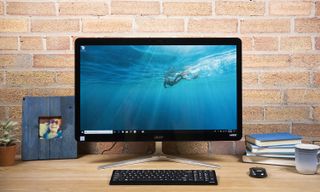
Watching the trailer for Jurassic World: Fallen Kingdom, I could make out individual whiskers in Chris Pratt’s mustache, and the scaly skin of a sleeping Tyrannosaurus rex had a distinctive, pebbled surface. Lush jungle scenes were filled with greens and a mysterious scene in a lab showed brightly colored vials on ice in a suitcase.
It's also a touch screen with a capacitive touch sensor that can register up to 10 points of touch simultaneously. Whether you want to get all of your fingers on the screen at once, or enjoy a two-player game on the 27-inch screen, you’ll be just fine.
In actual testing, the display proved itself to be pretty decent. The brightness is slightly above average, registering 256 nits, as compared to the Dell Inspiron 27 7000 (212 nits) and the Asus Zen AiO Pro Z240IE (247 nits). However, the eye-popping Apple iMac showed how much further a display can go, with a max brightness of 434 nits.
Color accuracy was a little less impressive, and our colorimeter and calibration software showed it to have a Delta-E rating of 1.79 (closer to 0 is better), which isn't bad, but it's less impressive than the Dell Inspiron 27 7000 (0.59), the Asus Zen AiO Pro Z240IE (0.28) or the Apple iMac (0.06).
Watching the trailer for Jurassic World: Fallen Kingdom, I could make out individual whiskers in Chris Pratt’s mustache, and the scaly skin of a sleeping Tyrannosaurus rex had a distinctive, pebbled surface.
Finally, the display is capable of reproducing a satisfactory 110 percent of the sRGB color spectrum. While we consider anything at or above 100 percent to be passable, this is still on the low side. The Dell Inspiron 27 7000 (120 percent), the Asus Zen AiO Pro Z240IE (146) and the Apple iMac (167 percent) all offer a wider gamut, which translates into significantly better color quality.
Audio
The Aspire U27 features a pair of 2-watt speakers, with a downward-firing arrangement that reflects sound off your desk surface instead of disrupting the face of the all-in-one with speaker grilles. The speakers put out quite a bit of sound, and can be turned up loud enough to be heard in the next room.
The audio quality was also quite good. When I listened to "Cold As Stone" by Kaskade and Charlotte Lawrence, I was pleased to not only hear clear, natural-sounding vocals, but a punchy bassline, as well. The full bass is thanks to a built in subwoofer, which uses a patented resonating chamber design to pump out bigger sound than the subwoofer's tiny size might normally lend itself to.
MORE: The Best All-in-One Computers
Is there better audio available on other all-in-one PCs? Sure, but you'll need to fork over the extra cash for premium offerings like the 10-speaker Dell XPS 27 7760, which holds the audio quality throne by sheer numbers – we could devote a full paragraph to listing its array of tweeters, drivers and other speaker types. However, the Aspire U27 is one of the few systems that doesn't demand a set of headphones or speakers for decent audio quality.
Keyboard and Mouse
The Aspire U27 comes with a wireless keyboard and mouse that share a single tiny wireless USB adapter. They're a matched set, with a black plastic construction that contrasts glossy piano black with a simple matte finish on the keyboard keys and the portions of the mouse you grip.

The keyboard is set at a comfortable angle, with square tile keys, including a row of half-size function keys along the top row. The depth of the key travel is on the shallow side (1.8 millimeters), but it'll do for light use.The mouse is a basic ambidextrous optical mouse. The plastic construction doesn't feel very substantial, but it'll get you by.
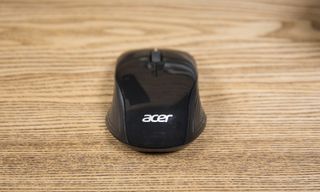
Given the amount of time I spend using a keyboard, I'd upgrade to something a little sturdier and more ergonomically sound, but that's a personal call. As bundled peripherals go, Acer has included a fairly decent option for light use.
Ports
On the back of the sleek unibody chassis you'll find connections for power and gigabit Ethernet, along with HDMI in and out ports, three USB 3.0 ports and a single Thunderbolt 3 port, which uses the compact, reversible USB Type-C connector.
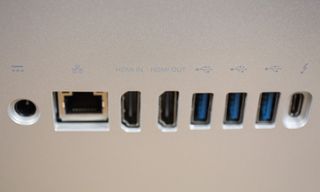
That HDMI input enables one of our favorite features, the ability to use an all-in-one as a stand-alone monitor even after you've moved on to another PC.
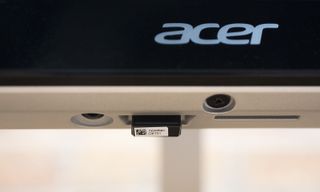
On the bottom of the chassis, you'll find a monitor button that pulls up the display's on-screen settings menu, which is perfect for adjusting the settings without ever having to go through the OS. There's also an SD card slot, and a USB 2.0 slot that comes occupied by the wireless dongle for the included keyboard and mouse.
Performance
The U27 is one of many all-in-one desktops that use the same mobile processing hardware found in laptops. In this case, it uses an Intel Core i7-7500U, a 7th-generation dual-core processor, paired with 16GB of memory and a dual-drive solution that offers a 256GB SSD boot drive and 1TB HDD for more spacious storage.
The laptop processor is nowhere near as powerful as a proper desktop-class CPU, or even the most powerful notebooks, but it's perfect for most daily uses. I used the system with several browser tabs open, with everything from Twitter to streaming YouTube videos and Spotify music. It did fine at 15 tabs, but slowed at 20. With multiple media streams open, it showed noticeable lag.
MORE: The Best Gaming Desktops Available Now
Document work and web browsing should be a breeze, and streaming media will be quick and speedy, provided you're streaming one thing at a time. Creating media, on the other hand, won't be so quick. If you plan to do a lot of photo editing, file transcoding or even video editing, you'll be better served by something like the Dell XPS 27 7760, which boasts more powerful desktop processing and a discrete graphics card for extra muscle.
That's not to say the Aspire U27 has disappointing performance. On the contrary, it fares pretty well against the competition.
In our file transfer test, the U27 copied over our 4.97 GB test folder in 28 seconds, which works out to 181.76 MBps. That handily beats both the Dell Inspiron 27 7000 (87.75 MBps) and the Asus Zen AiO Pro Z240IE (101.78 MBps), but can't top the Apple iMac (710 MBps), which had one of the fastest speeds in the category. That impressive speed is thanks to the 256GB SSD that functions as the boot drive, allowing the system to be a little more nimble than competitors that rely solely on traditional hard drives.
With multiple media streams open, the U27 showed noticeable lag.
Processor performance was a slightly different story. In Geekbench 4 the Aspire U27 scored 8,004. Armed with true desktop-grade CPUs, the Asus Zen AiO Pro Z240IE (11,187; Intel Core i7-7700T) and the Dell Inspiron 27 7000 (18,374; AMD Ryzen 7-1700) handily beat it, and the Apple iMac (19,773; Intel Core i7-770K) pushed even further ahead.
Our spreadsheet macro tests also highlighted the limitations of the dual-core processor. In an Excel spreadsheet with 20,000 entries to chew through, the Aspire U27 took 2 minutes and 25 seconds to pair names with addresses. By comparison, the Acer Aspire S24 has a newer quad-core Intel Core i5-8250U and completed the same task in 1:20. You can still tackle multi-threaded tasks with the dual-core CPU in the U27, but it won't be as peppy as a quad-core would offer.
Single-thread performance, on the other hand, is fairly competitive. Running the same spreadsheet test in OpenOffice (which has no multi-thread capabilities) the Aspire U27 finished the same task in 3:34. The quad-core equipped Acer Aspire S24 was slightly slower (3:40), as was the Asus Zen AiO Pro Z240IE (3:40), and the Dell Inspiron 27 7000 (4:46) fell even further behind. Only the Apple iMac (1:57) offered better, with a high-end desktop CPU that offers more power for both single- and multi-thread processing.
Graphics
Equipped with only Intel's HD Graphics 620 – a graphics solution that shares silicon with the processor, instead of being a separate component – the Aspire U27 isn't well-suited to gaming or other graphics intensive applications.
In Dirt 3, our low-end gaming test, the U27 managed to produce 29.63 frames per second (fps), falling just short of the 30 fps threshold for basic playability. Considering that systems equipped with a real GPU, like the Dell Inspiron 27 7000 (123.62 fps, AMD Radeon RX 580), offer drastically better performance, you'll definitely want something with discrete graphics if you want a system you can actually game on.
This same disparity can be seen in the results of 3DMark's Ice Storm Unlimited rendering test, where the Aspire U27 scored 78,368 and the Dell Inspiron 27 7000 scored 96,512. The two aren't even in the same class on the graphics front.
Webcam
The Aspire U27 has a built-in 1080p webcam centered in the bezel above the display. There's also a second IR camera for Windows Hello, and a pair of mics for audio capture and filtering out ambient noise during video chats.

The webcam did well with basic image capture, but my face looked a bit gray.
Software and Warranty
The Aspire U27 comes ready to go with Windows 10. It comes with all of the usual features, complete with an IR camera for Windows Hello – which lets you log in with facial recognition – and the Cortana voice assistant.
MORE: How to Use Windows 10
The usual Microsoft apps are there, like Skype, Paint 3D and trial versions of Microsoft Office and Norton Security. There's also the usual bloatware, like Dashlane Password Manager, Music Maker Jam, Netflix and a bunch of game samples from WildTangent Games, along with retail offerings from Amazon, eBay and more. Acer includes a few of its own apps, like Acer Portal, and it's proprietary abPhoto and abFile cloud services.
Acer covers the Aspire U27 with a one-year warranty.
Configurations
A few versions of the U27 are available, with options for different components in the same chassis. Our review unit, the U27-880-UR11, is outfitted with an Intel Core i7-7500U processor, 16GB of memory and two drives – a 256GB SSD and 1TB HDD – that deliver good speed and plenty of storage space.
Other configurations include the U27-880-UR14, which has a less-powerful Intel Core i5-7200U CPU, 8GB of RAM and a single 1TB HDD for $1,199.
Stepping up in power and price, there's the U27-880-UR13, which has the same Core i7 processor and 16GB of RAM seen in our review unit, but has only a 1TB HDD, with no SSD. It sells for $1,399.
Bottom Line
The Acer Aspire U27 has some very cool features going for it. The fanless liquid cooling built into the system keeps things quiet, while the 2.1 audio delivers excellent sound. The overall look of the system is great, and the performance is more than enough for day-to-day uses.
But in this price range, you can do better. Systems like the Asus Zen AiO Pro Z240IE offer a better mix of desktop-class performance and 4K display. And if you really had your heart set on the 27-inch display, you'll still do better with the Dell Inspiron 27 7000, which boasts 4K and discrete graphics for gaming.
Credit: Tom's Guide
Sign up to get the BEST of Tom’s Guide direct to your inbox.
Upgrade your life with a daily dose of the biggest tech news, lifestyle hacks and our curated analysis. Be the first to know about cutting-edge gadgets and the hottest deals.
Brian Westover is currently Lead Analyst, PCs and Hardware at PCMag. Until recently, however, he was Senior Editor at Tom's Guide, where he led the site's TV coverage for several years, reviewing scores of sets and writing about everything from 8K to HDR to HDMI 2.1. He also put his computing knowledge to good use by reviewing many PCs and Mac devices, and also led our router and home networking coverage. Prior to joining Tom's Guide, he wrote for TopTenReviews and PCMag.

